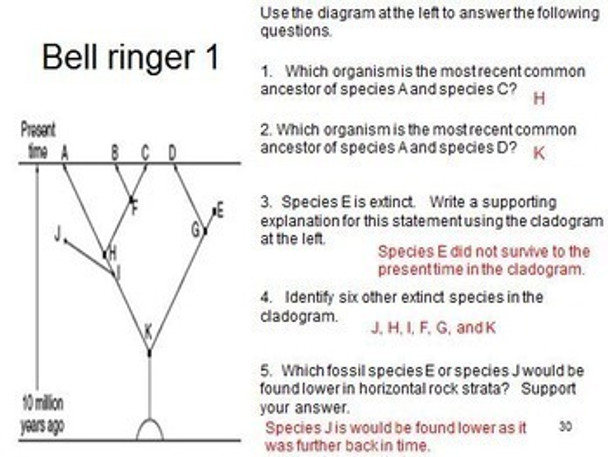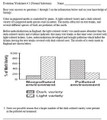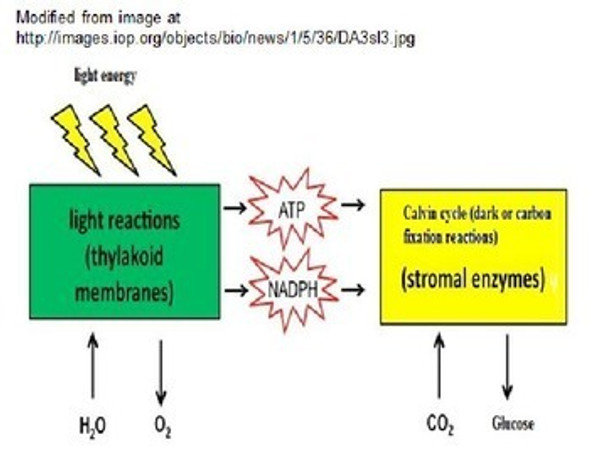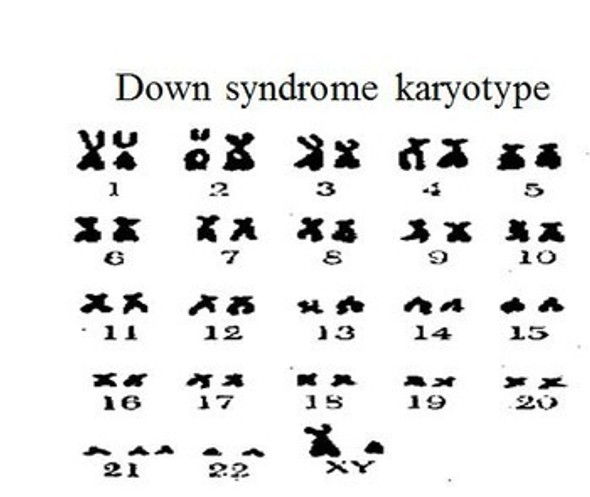Description
This zip file contains 9 different documents/materials which can be used to compose a unit for biology students introducing them to evolution. Evidences for evolution, natural selection, examples of evolution in modern times, introduction to cladograms and the heterotroph hypothesis are among the major topics in the materials in this zip file. A specific listing of the learning goals addressed by the components of this zip file appears later in this description.
Documents have been provided in both pdf and editable word format to allow you to tailor these materials to your course and your students. These documents are well suited for use in distance learning environments.
These lessons have been correlated to the NGSS, Common Core and NY Living Environment Core Curriculum standards.
The zip file contains the following items:
- Marzano self assessment scale for students specific to this unit
- Cloze completion notes handout for students with learning goals
- 96 slide PowerPoint to accompany the cloze notes with 6 bellringer activities with answers in the PowerPoint
- Evolution worksheet 1 (evidences for evolution) with key
- Evolution worksheet 2 (Darwin and the theory of natural selection) with key
- Evolution worksheet 3 (Natural Selection) with key
- Evolution worksheet 4 (Cladograms/Modern Natural Selection) with key
- Evolution practice quizzes 1 and 2 for students with answers for study purposes
- Evolution quiz 1 with key
- Evolution quiz 2 with key
- Evolution Jeopardy Game PowerPoint
- Curriculum Correlations to the NGSS, Common Core and NY Living Environment Core Curriculum standards
Evolution Learning Goals
Upon completion of this unit the student will:
1. define the term evolution and recognize that current life forms have evolved from earlier life forms.
2. recognize that evolution provides an explanation for the differences in structure, function, and behavior among life forms.
3. recognize that radioactive dating has determined the approximate age of the earth as 4.6 billion years.
4. define the term fossil and list examples of these.
5. state the law of superposition and relate it to the age and complexity of fossils found in undisturbed horizontal rock layers (strata).
6. explain how observations of fossils in adjacent rock strata often support the theory of evolution.
7. explain how gene mutations may be increased in incidence.
8. recognize that gene mutations can only be passed on to the offspring if they occur in an organism's sex cells.
9. state Darwin's theory of natural selection and explain the following features in his theory; overproduction, competition, variations, survival of the fittest, reproduction, and speciation.
10. define the term adaptive variations.
11. explain some weaknesses of Darwin's theory and compare the modern natural selection theory to that of Darwin.
12. state two sources of variation not recognized by Darwin.
13. explain the modern theory of natural selection.
14. explain why increased genetic diversity tends to enhance the survival of a species.
15. recognize traits beneficial to an organism enhance its survival, while traits which are not beneficial hurt its chances for survival.
16. explain the following examples of evolution in modern times in terms of the theory of natural selection; peppered moth, insect resistance to insecticides, bacterial resistance to antibiotics.
17. recognize that evolutionary factors operate on populations, not individual organisms.
18. describe the variety of pathways evolution may take.
19. recognize that the extinction is common and may occur when the adaptive characteristics of an organism no longer support its survival.
20. state the purpose of classification and recognize that the species is the fundamental unit of classification.
21. recognize that organisms are classified based on structural similarities and evolutionary relationships.
22. realize that differences between parents and offspring can accumulate over generations so that descendants become different from their ancestors.
23. recognize that the more similar two organisms DNA sequences, the more closely related they are from an evolutionary standpoint.
24. recognize that 3 to 4 billion years ago it is thought that the first primitive life appeared on the earth.
25. explain briefly the heterotroph hypothesis.
26. recognize that about 1 billion years ago, increasingly complex multicellular organisms began to appear.
27. recognize that the great diversity of organisms is the result of billions of years of evolution that has filled the niches of the earth with life forms.
28. interpret phylogenetic trees/cladograms to determine common ancestry and answer other basic life history questions about organisms.
NGSS Standards
Students who demonstrate understanding can:
HS-LS3-2. Make and defend a claim based on evidence that inheritable genetic variations may result from: (1) new genetic combinations through meiosis, (2) viable errors occurring during replication, and/or (3) mutations caused by environmental factors.
HS-LS4-1. Communicate scientific information that common ancestry and biological evolution are supported by multiple lines of empirical evidence.
HS-LS4-2. Construct an explanation based on evidence that the process of evolution primarily results from four factors: (1) the potential for a species to increase in number, (2) the heritable genetic variation of individuals in a species due to mutation and sexual reproduction, (3) competition for limited resources, and (4) the proliferation of those organisms that are better able to survive and reproduce in the environment.
HS-LS4-3. Apply concepts of statistics and probability to support explanations that organisms with an advantageous heritable trait tend to increase in proportion to organisms lacking this trait.
HS-LS4-4. Construct an explanation based on evidence for how natural selection leads to adaptation of populations.
HS-LS4-5. Evaluate the evidence supporting claims that changes in environmental conditions may result in: (1) increases in the number of individuals of some species, (2) the emergence of new species over time, and (3) the extinction of other species.
Common Core State Standards Connections:
ELA/Literacy
RST.11-12.1 Cite specific textual evidence to support analysis of science and technical texts, attending to important distinctions the author makes and to any gaps or inconsistencies in the account.
RST.11-12.8 Evaluate the hypotheses, data, analysis, and conclusions in a science or technical text, verifying the data when possible and corroborating or challenging conclusions with other sources of information.
WHST.9-12.1 Write arguments focused on discipline-specific content.
WHST.9-12.2 Write informative/explanatory texts, including the narration of historical events, scientific procedures/ experiments, or technical processes.
WHST.9-12.9 Draw evidence from informational texts to support analysis, reflection, and research.
Mathematics
MP.2 Reason abstractly and quantitatively.
NY Living Environment Core Curriculum
Performance Indicator 3.1
Explain the mechanisms and patterns of evolution.
Major Understandings
3.1a The basic theory of biological evolution states that the EarthÕs present-day species developed from earlier, distinctly different species.
3.1b New inheritable characteristics can result from new combinations of existing genes or from mutations of genes in reproductive cells.
3.1c Mutation and the sorting and recombining of genes during meiosis and fertilization result in a great variety of possible gene combinations.
3.1d Mutations occur as random chance events. Gene mutations can also be caused by such agents as radiation and chemicals. When they occur in sex cells, the mutations can be passed on to offspring; if they occur in other cells, they can be passed on to other body cells only.
3.1e Natural selection and its evolutionary consequences provide a scientific explanation for the fossil record of ancient life-forms, as well as for the molecular and structural similarities observed among the diverse species of living organisms.
3.1f Species evolve over time. Evolution is the consequence of the interactions of (1) the potential for a species to increase its numbers, (2) the genetic variability of offspring due to mutation and recombination of genes, (3) a finite supply of the resources required for life, and (4) the ensuing selection by the environment of those offspring better able to survive and leave offspring.
3.1g Some characteristics give individuals an advantage over others in surviving and reproducing, and the advantaged offspring, in turn, are more likely than others to survive and reproduce. The proportion of individuals that have advantageous characteristics will increase.
3.1h The variation of organisms within a species increases the likelihood that at least some members of the species will survive under changed environmental conditions.
3.1i Behaviors have evolved through natural selection. The broad patterns of behavior exhibited by organisms are those that have resulted in greater reproductive success.
3.1j Billions of years ago, life on Earth is thought by many scientists to have begun as simple, single-celled organisms. About a billion years ago, increasingly complex multicellular organisms began to evolve.
3.1k Evolution does not necessitate long-term progress in some set direction. Evolutionary changes appear to be like the growth of a bush: Some branches survive from the beginning with little or no change, many die out altogether, and others branch repeatedly, sometimes giving rise to more complex organisms.
3.1l Extinction of a species occurs when the environment changes and the adaptive characteristics of a species are insufficient to allow its survival. Fossils indicate that many organisms that lived long ago are extinct. Extinction of species is common; most of the species that have lived on Earth no longer exist.
Appendix A -- Lab Skills
¥ Organizes data through the use of data tables and graphs
¥ Analyzes results from observations/expressed data
¥ Formulates an appropriate conclusion or generalization from the results of an experiment
¥ Recognizes assumptions and limitations of the experiment
Bundle and Save!
Many more biology materials are available from Monday's Rescue. The Biology/Life Science Course contains 22 units which can be used to develop a full year course. A purchase of the Biology/Life Science Course provides significant savings of over 70% compared to purchasing each of the 22 units individually. This course is available for $24.99. It contains over 900 pages of learning materials and 1500 plus PowerPoint slides.
This year long course contains the following units:
- Life Processes and Introduction to Classification Learning Activities
- Cell Structure and Function Lesson Activities
- Membrane and Membrane Processes Learning Activities
- Introduction to Biochemistry and Enzymes Lesson Activities
- Human Nutrition Learning Activities
- Human Circulation Learning Activities
- Immunity Lesson and Lab Activities
- Human Respiration Learning Activities
- Introduction to Cell Respiration Learning Activities
- Introduction to Human Excretion and Human Locomotion Learning Activities
- Nervous and Endocrine Systems Lesson Activities
- Introduction to Mitosis and Asexual Reproduction Lesson Activities
- Introduction to Meiosis Lesson Activities
- Reproduction and Development Lesson Activities
- Plant Systems and Adaptations Lesson Activities
- Photosynthesis Learning Activities
- Plant Reproduction and Development Lesson Activities
- Classical Genetics Learning Activities (Mendelian and Beyond Mendel)
- Introduction to DNA, RNA, Protein Synthesis and Biotechnology Lesson Activities
- Introduction to Evolution Lesson Activities
- Ecology Lesson Activities
- Human Ecology Learning Activities
- Complete NY State Living Environment Regents Review Packets with Answers
View the contents of the whole year course in more detail at Biology/Life Sciences Complete Course
Terms of Use
Purchase of the product is for classroom use by the purchaser only. It is a violation for individuals, schools, and districts to redistribute or sell this item on the Internet or to other individuals. I do encourage you to use and edit these documents to suit your needs with your own students in distance learning environments.
This work is licensed under a Creative Commons Attribution-NonCommercial-ShareAlike 4.0 International License.


























